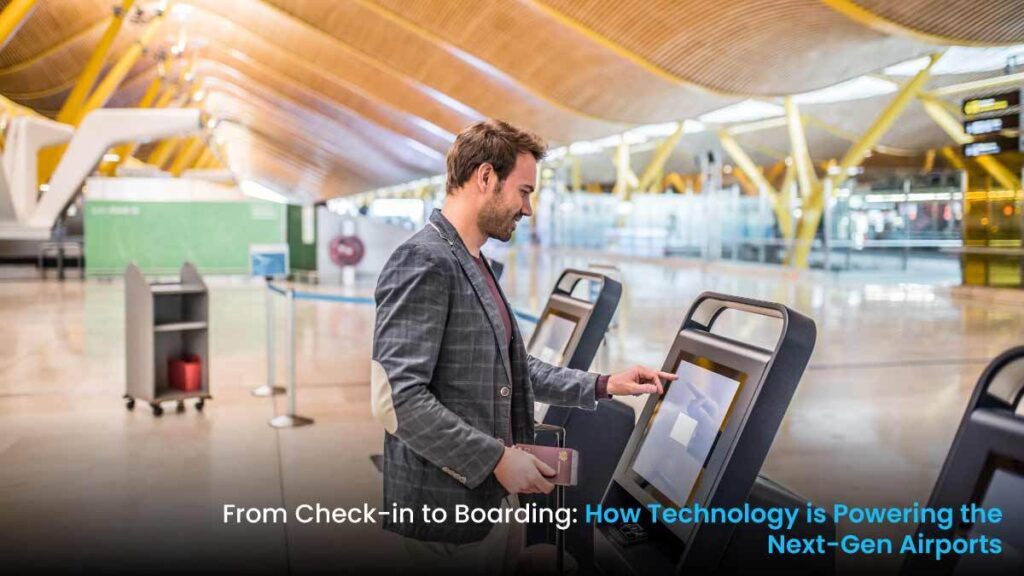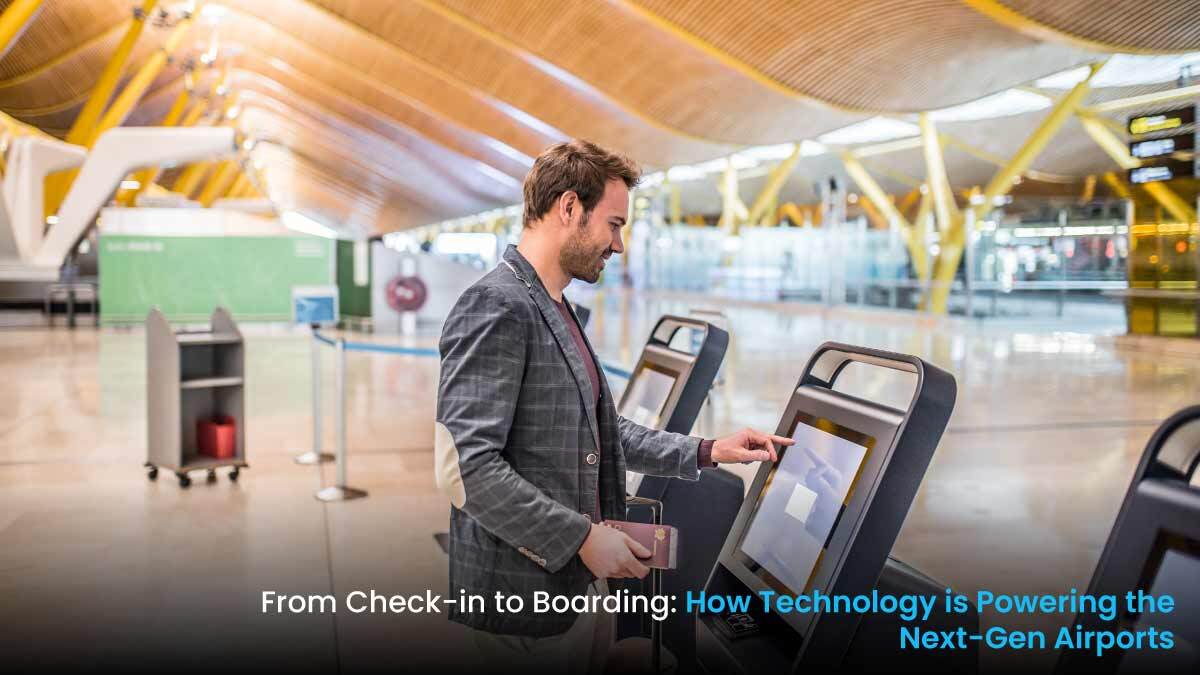
Consider your arrival at an airport where security lines have been eliminated, check-in is instantaneous, and boarding is a smooth transition rather than a hectic rush. Doesn’t it sound like a dream? It’s strange, but it seems like we’re living in a sci-fi movie at the airport these days. But it’s more than just a feeling; AI is transforming the way we fly. Airports all around the world are getting on the tech bandwagon in an effort to make the entire travel experience less stressful. Consider this: fewer queues, smoother check-ins, and a more enjoyable overall experience. I’m talking about robots, clever computers, and buildings that can almost think for themselves.
Let’s take a look at how some airports are abandoning old practices and ushering in a new era of travel.
The Future of Check-in: Touchless and Hassle-Free
Goodbye to these long lines of passengers waiting around the check-in counters! AI is making airports a whole lot smarter. Now you can skip the first steps with self-service kiosks and easy mobile check-in on your phone. It is like magic, and gets you on the road quicker than ever! Oh, and many airports are now using facial recognition to verify your identity. Forget hunting for boarding passes and IDs; a single glance does the job. Big-name airlines, the ones flying those Boeings and Airbuses, are all jumping on board with this face-scanning tech to make things safer and faster for everyone.
If you’re a regular in the skies, digital passports and AI-powered ID checks are about to become your new best friends. Imagine just showing your face and being able to check in, drop off your luggage, and head straight to security – talk about a game-changer! AI is working behind the scenes as well, aiding airlines and airports in real-time understanding of how passenger flow is moving. By monitoring check-in data as it comes in, they’re able to forecast when things are about to get busy. That allows them to deploy the right number of people and skeletal resources, so you’re waiting less time in line, especially during those busy travel periods.
Additionally, mobile apps are becoming smarter, offering automated flight check-ins, personalised travel recommendations, and real-time alerts about potential delays. Some airports have even introduced contactless bag-drop systems, where AI scans luggage dimensions and weight instantly, reducing human intervention and long queues.
An additional innovation that has improved check-in efficiency is the implementation of digital queuing systems. By planning their check-in times in advance, travellers can bypass standing in overcrowded areas and have a hassle-free experience. The entire check-in process is becoming a more efficient and user-friendly experience as more airports adopt these technologies.
Security Screening: Faster and Safer Than Ever
The airport security line may be the most stressful part of travel. But automation and AI are doing it faster and more efficiently. AI-powered scanners can now identify prohibited items without forcing passengers to take liquids and electronics out of their bags. This speeds up the process and reduces human errors, thus improving security.
Also being rolled out are smart security lanes that use AI to monitor passenger behaviour and detect threats in real time. These progressions enable airports to maintain high safety standards without hindering efficiency.
Smart Boarding: Say Goodbye to Long Queues
Another stage where technology is having a significant impact is boarding. Passengers can board without presenting their tickets thanks to automated gates that use facial recognition technology. Biometric boarding systems are being used by airlines to ease traffic and improve efficiency. As a result, travellers can board their flights more quickly, and airlines can more reliably guarantee on-time departures.
AI-driven boarding sequences are also being used by some airports to control passenger flow and eliminate the need for congested waiting areas. This guarantees faster aircraft turnaround times and enhances the travel experience.
The Role of Airport Digital Signage in Enhancing Passenger Experience
Imagine walking through an airport and instantly finding your way without stopping to check a map. That’s the power of airport digital signage. These high-tech displays provide real-time updates on flights, baggage claim areas, and even the shortest routes to your gate.
Beyond just navigation, digital signage is being used to enhance passenger engagement. Airports are integrating AI to personalise information based on passenger profiles, displaying tailored messages, offers, and guidance to make journeys smoother.
Baggage Handling: No More Lost Luggage
One of the biggest frustrations for travellers is lost or delayed baggage. Thankfully, AI and automation are transforming baggage handling. Smart luggage tags with real-time tracking allow passengers to monitor their bags’ location via mobile apps.
AI-driven conveyor belt systems use robotics to sort and transport luggage more efficiently. Airports adopting these systems have seen a significant reduction in lost baggage cases, making travel stress-free for passengers.
AI Airport Services: A New Era of Customer Support
Ever had a question at the airport but couldn’t find the right person to ask? AI-powered chatbots and virtual assistants are now providing instant help to passengers. These smart assistants, available on airport apps and kiosks, answer queries about flights, baggage, and airport facilities in multiple languages.
For airlines operating Boeing and Airbus aircraft, AI-driven predictive maintenance is also ensuring smoother operations by identifying potential issues before they cause delays. This means fewer flight disruptions and a more reliable travel experience.
Training the Next Generation of Pilots in a High-Tech Era
With aviation technology advancing rapidly, pilot training is also evolving. The IndiGo Cadet Pilot Programme and other pilot training in India initiatives are incorporating AI-driven simulators to provide more immersive training experiences. These simulators replicate real-world flight conditions, helping aspiring pilots develop their skills with high precision.
AI is also being used to analyse trainee performance, providing personalised feedback and ensuring that pilots are well-prepared for real-world flying challenges. As technology reshapes aviation, it’s essential that future pilots are equipped with the skills to navigate the industry’s digital transformation.
Final Thoughts: The Airport of Tomorrow
The next-gen airport is no longer just a concept—it’s becoming a reality. From AI airport services improving efficiency to airport digital signage enhancing passenger experience, technology is redefining air travel at every step. With innovations in automation and AI, passengers can look forward to a smoother, faster, and more enjoyable journey.
As airlines continue to modernise their fleets with the latest Boeing and Airbus aircraft and as training programmes like Insight Aviation’s IndiGo Cadet Pilot Programme adapt to the digital age, the future of aviation looks more exciting than ever. So the next time you step into an airport, take a moment to appreciate how far technology has come—because the airport of the future is already here.
FAQs
Q: How is biometric technology improving the airport check-in process?
A: Facial recognition and fingerprint scans enable faster, contactless check-ins.
Q: How does RFID technology enhance baggage tracking?
A: RFID tags provide real-time baggage tracking, reducing lost or mishandled luggage.
Q: How is automation changing the boarding process?
A: Automated boarding gates scan boarding passes, speeding up passenger flow.
Q: What role does AI play in airport operations?
A: AI optimizes flight schedules, predicts delays, and improves security screening.
Q: What are e-Gates, and how do they speed up security and boarding?
A: e-Gates use biometrics to verify identity, allowing quicker security checks and boarding.
Q: What is the role of 5G in next-gen airports?
A: 5G enables faster communication, real-time data sharing, and better passenger services.

